Lightly boiled and perfectly salted, edamame is the classic Japanese appetizer. They’re delicious to snack on and packed with a nutritional punch. Learn how to prepare these young soybean pods with the authentic Japanese method.
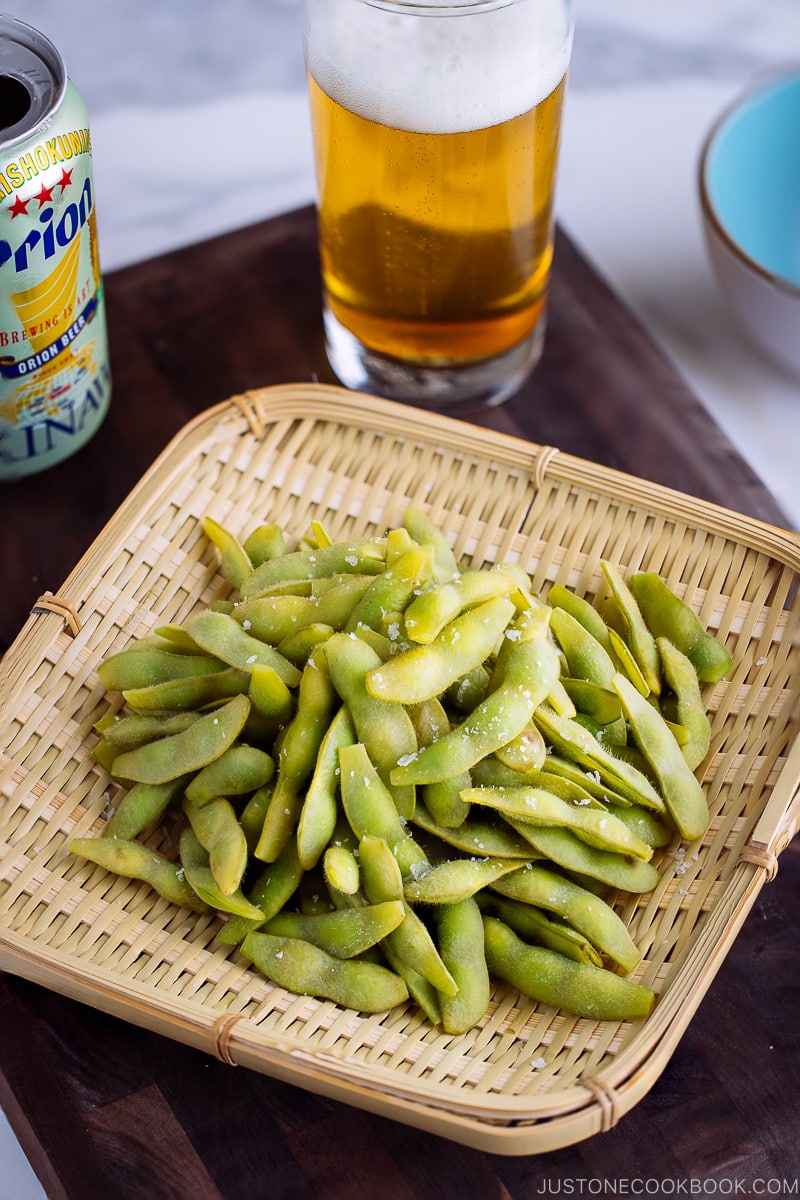
Edamame (枝豆) are most popularly known as the little snack or appetizer that is brought to you when you sit down at a table at a Japanese restaurant.
With a sweet buttery taste, these lightly boiled or steamed soybeans are not only delicious, but they’re also fun to munch on while waiting for the rice bowl or ramen or sushi platter to be served. In this recipe, I’ll show you the easy Japanese method of how to cook edamame, both frozen and fresh, at home.
Table of Contents

What is Edamame?
Edamame are edible soybeans that are harvested and picked when they are young and green. If you’re wondering, they are the same soybeans as the matured soybeans used to make tofu, soy milk, natto, and soy sauce. They are full of plant-based protein perfect for vegetarian or vegan diets!

In Japanese, the name edamame literally means ‘stem beans (枝豆)’ as they are often sold while still encased in pods with the stems attached. Long been consumed in Japan since ancient times, edamame is now considered a mainstream ingredient in the US.
The most common way to enjoy and eat edamame is by boiling them in pods in salted water and enjoy as a snack or appetizer. We also enjoy the shelled edamame beans as an easy side or pair them with a great variety of dishes.
How to Pronounce Edamame?
It is pronounced eh-DAH-ma-meh in Japanese although many English speakers pronounce the name more like ay-duh-MAH-may.

Health Benefits of Edamame
Low in calories and high in fiber, edamame have always been considered a superfood in Japan that delivers many nutritional value. Just 1/2 cup of these soybeans a day punches up the vitamin and mineral content of the diet needed by our bodies!
There are plenty of reasons to include edamame in your diet, and here are just some of the top benefits:
- High in Dietary Protein: As the only plant-based source of complete protein, edamame provides all 9 essential amino acids needed for the body, which may help reduce insulin resistance and prevent hypertension. A great protein choice for those who follow a vegetarian or plant-based diet! They also keep you full and satisfied, so it makes a great healthy snack for weight loss.
- High in Calcium: The calcium in the soybeans may help to increase bone mineral density, regulate blood sugar and lessen symptoms of premenstrual syndrome (PMS) among women.
- Rich in Vitamins, Magnesium, and Minerals: Edamame is also rich in several vitamins and minerals, especially vitamin K and folate. Adequate folate intake is particularly important for pregnant women and young children as it is responsible for red blood cells and brain health. The plant compounds are essential to lower cholesterol.
- High in Iron: For plant food, edamame provides an excellent source of iron. Sufficient iron is essential to transport oxygen throughout the body, ensuring the energy level of our bodies. It is also necessary to maintain the health of our skin, hair, and nails.
- Rich in Phytonutrients: A rich source of phytonutrients like isoflavones, saponins, phytosterols, and carotenoids, edamame provide antioxidants and anti-inflammatory that help lower the risk of cancer.

Where Can You Buy Edamame
Edamame are as common as peas where you can find them being sold in plastic bags in the freezer aisle at most grocery stores. You can buy edamame four ways:
- Fresh edamame pods;
- Frozen edamame pods;
- Frozen shelled edamame; and
- Precooked shelled edamame.


The fresh edamame pods are in season between June to September, so you can hunt for them in your local Japanese grocery stores or farmers markets! Look for fresh pods with stems attached and they should look bright, plump, and slightly fuzzy.
For this classic Japanese edamame recipe, we’re looking for edamame pods! If you can’t find fresh pods, you can use frozen unshelled edamame by following my recipe tips below.

3 Mistakes on the Frozen Edamame Package You Should Not Follow
Frozen edamame pods are probably the most easily accessible to everyone. The packages come with instructions at the back, but please take note on these three things:
- The amount of salt – If you’re planning to serve your edamame as a Japanese appetizer or snack (the way we eat in Japan), 1/2 tsp of salt in the instructions does NOTHING to your edamame pods. You need to flavor the edamame with salt, and soybeans are INSIDE the pods. The rule of thumb is 4% salt. Why 4%? We’ll discuss more later.
- Cooking time – Every package instruction is slightly different. I’ve seen instructions like “Cook 6-8 minutes” and “Return to a boil. Cook for 4-5 minutes.” In general, the cooking time for the majority of the packaging is a bit too long. The edamame will be too mushy. They have to be cooked al dente (firm to the bite). Once removed from the boiling water, the edamame will continue to cook a tad more with the remaining heat.
- Run in cold water – Big no-no, even if you want to serve edamame cold! Definitely never run cooked edamame in cold running water. Sprinkle a bit of salt while the edamame are hot.

Let’s Talk about 4% Salt
In Japan, the rule of thumb is to boil edamame in 4% salt water.
For comparison, saltwater is 3.5%. If you use Diamond Crystal kosher salt, you need to add 4 Tbsp (40 g) of salt to 1 QT (1 Liter) of water.
You may ask why so much salt. When I first learned it, I had the same thought, too!
I learned that edamame pods are very thick (true!) and the soybeans won’t be able to absorb the flavor fully unless you use the right amount of salt. I’ve tried different % for fun, and if you follow the edamame package instructions, the soybeans would taste rather bland. That’s not how we enjoy edamame in Japan!
Trust me, I’ve been cooking my edamame with 4% salt and they are literally the perfect amount and your edamame will never come out salty.
Since the salt in the cooking water is for seasoning soybeans (inside the pods), it’s really up to you how much flavor you want for your edamame. If you have tried the edamame pods in Japan and wish to replicate that flavor, then definitely use 4% salt.
It is not required to sprinkle salt after cooking in saltwater. However, you can sprinkle a tiny bit, if desired. White speckles of salt look appetizing (the classic look!) and when you bite into the pods, that salty mouthfeel will make you crave for more.

How to Cook Frozen Edamame Pods
- Bring 1 QT (1 L) of water in a large pot to a boil and add 4% salt. Save some salt for sprinkling after cooking. Why 4%? Read the section above.
- Read the package of your unshelled edamame carefully because they can be partially cooked, fully cooked, or totally uncooked. This obviously changes the cooking time.
- Partially cooked – 2 to 3 minutes
- Uncooked – 4 to 5 minutes (based on the size of soybeans)
- Fully-cooked – 1 minute (If your package is imported from Japan, the edamame are always fully cooked; you just need to defrost in boiling water)
- Cook edamame in salt water.
- Drain well (do not rinse). Sprinkle a little bit of salt and let cool slightly. Serve warm or at room temperature.

How to Cook Fresh Edamame Pods
- Cut off both ends of the pods. I still remember spending my summer evenings at my grandma’s house where I was assigned the task of trimming edamame pods. Do you know why we cut off both ends of the pods? We do that so the salt water will season the soybeans inside the pods when boiling. What a neat trick, isn’t it?
- Rub fresh edamame with salt. Take 1 tablespoon out of the 4% salt you prepared and sprinkle over the edamame pods. Now rub against each other. This helps to remove some of the fuzzy hairs on the pods. It also helps to retain the bright green of the pods and absorb flavors while cooking.
- Bring 1 QT (1 L) of water in a large pot to a boil and add the rest of the salt. Save some salt for sprinkling after cooking.
- Cook edamame in salt water for 4 minutes. Add the rest of the salt and salted edamame into the boiling water and cook for 4 minutes (depending on the size, roughly 3-5 minutes).
- Drain well (do not rinse). Sprinkle a little bit of salt and let cool slightly. Serve warm or at room temperature.

How to Serve and Eat Edamame
If you’re in Japan, you’ll most likely enjoy these fun snacks with some foamy cold beer. At home, you can serve edamame as a snack or appetizer in a serving bowl. I usually prepare another empty bowl for the discarded shells.

To eat, gently squeeze the soybeans out of the pods into your mouth, and discard the pod in a separate bowl.
Different Ways to Serve Edamame
The fresh pods of edamame are as great as a standalone snack, but you can also enjoy different variations. If you like the heat, make Spicy Edamame with various types of chili paste and hot sauce, like Sriracha and sambal oelek.
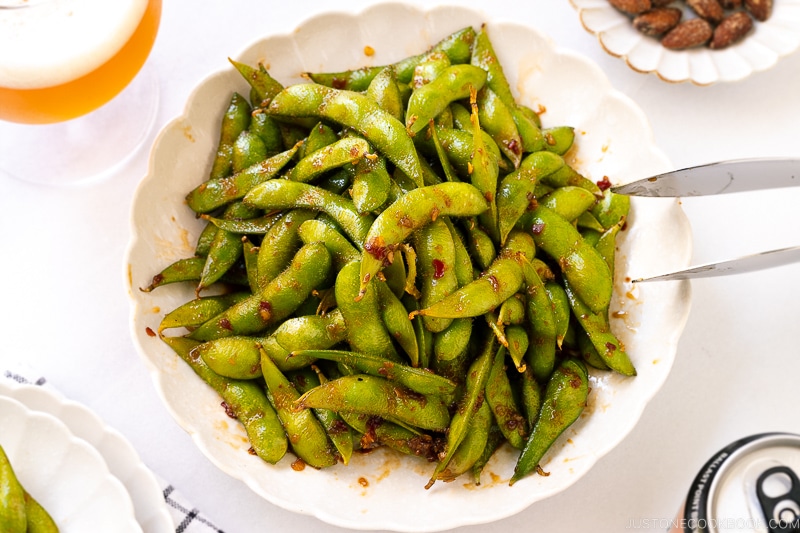
You can also enjoy shelled edamame beans in a variety of dishes. Try it in your salads, soba noodles, fried rice, miso soup, or rice bowls!

Wish to learn more about Japanese cooking? Sign up for our free newsletter to receive cooking tips & recipe updates! And stay in touch with me on Facebook, Pinterest, YouTube, and Instagram.

How to Cook Edamame
- 1 QT water (4 cups)
- 4 Tbsp Diamond Crystal kosher salt (The rule of thumb for cooking edamame in Japan is 4% salt water because of their thick pods (read the blog post); use 40 g salt per 1000 ml water (FYI, seawater is 3.5%); the soybeans will not taste too salty, trust me!; save some salt for sprinkling after cooking)
- 10 oz edamame (frozen or fresh, in pods; read the instructions carefully for "fresh" or "frozen"; you can increase up to 14 oz (397 g) but no more than that)
To Cook the Frozen Unshelled Edamame Pods
- Gather all the ingredients. These instructions are for frozen edamame pods. See the next section for fresh edamame pods.
- Add 1 QT water to a pot and bring it to a boil over medium-high heat. From the 4 Tbsp Diamond Crystal kosher salt, reserve ½ tsp kosher salt for sprinkling later and add the rest of the salt to the boiling water.
- Add 10 oz edamame pods (frozen) to the boiling salted water and cook, stirring once in a while, for 4–5 minutes, or until the soybeans are an al dente consistency. (Read the package instructions carefully and check if the soybeans are raw or cooked. Edamame imported from Japan are always precooked, so you only need to boil them for 1 minute to reheat.) If you see foam forming on the surface of the water, remove it with a fine-mesh skimmer because we do not rinse the pods after cooking.
- Drain in a colander and DO NOT RINSE, or the edamame will lose their salted flavor. While the edamame pods are hot, sprinkle with the reserved salt. Let them cool naturally so the edamame can absorb the seasoning.
- Serve the edamame warm or at room temperature. To eat, remove the soybeans from their inedible pods and enjoy.
To Cook the Fresh Unshelled Edamame Pods
- Gather all the ingredients. These instructions are for fresh edamame pods. See the previous section for frozen edamame.
- Remove the pods from the stems.
- Measure 10 oz edamame pods (fresh). Tip: If you do this once, you‘ll know the approximate weight next time without measuring.
- Add 1 QT water to a pot and bring it to a boil over medium-high heat. Meanwhile, use a pair of kitchen shears to cut off the tops and the tails of the pods, about 2–3 mm. If the water starts boiling, cover the pot and turn off the heat for now.
- Place the edamame in a bowl or tray and sprinkle 1 Tbsp kosher salt on the pods. Rub the salted pods against each other with your hands to remove the fuzz. Do not rinse off.
- From the 4 Tbsp Diamond Crystal kosher salt, reserve ½ tsp kosher salt for sprinkling later and add the rest of the salt to the boiling water. Then, add the salted pods to the pot.
- Cook on medium heat for 3–5 minutes, or until the soybeans are an al dente consistency. Stir occasionally to make sure all the pods are cooking evenly. Start checking for doneness after 3½ minutes. Tip: Since we do not run cold water on the edamame after boiling, I recommend slightly under-cooking them since the edamame will continue to cook in their residual heat once drained.
- If you see foam forming on the surface of the water, remove it with a fine-mesh skimmer because we do not rinse the pods after cooking.
- Drain in a colander and DO NOT RINSE, or the edamame will lose their salted flavor. While the pods are hot, sprinkle with the reserved salt. Let them cool naturally so the edamame can absorb the seasoning (If you did not cut the ends off the pods, please let them rest for at least 1 hour).
- Serve the edamame warm or at room temperature. To eat, remove the soybeans from their inedible pods and enjoy.
To Store
- If you want to preserve the edamame, cook the edamame, cool completely, and then freeze. You can defrost them naturally or you can quickly blanch them in boiling water or use a microwave to reheat.
Editor’s Note: This post was originally published on September 13, 2018. New content and images were added to the post on July 27, 2022.





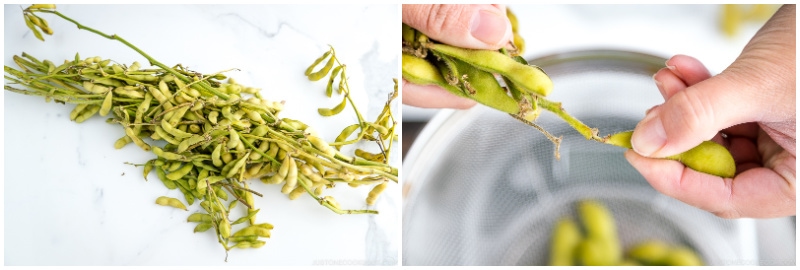
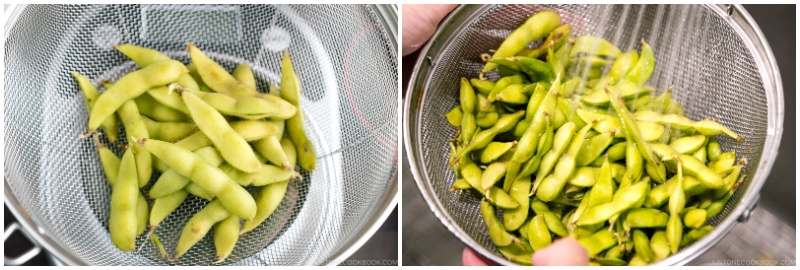



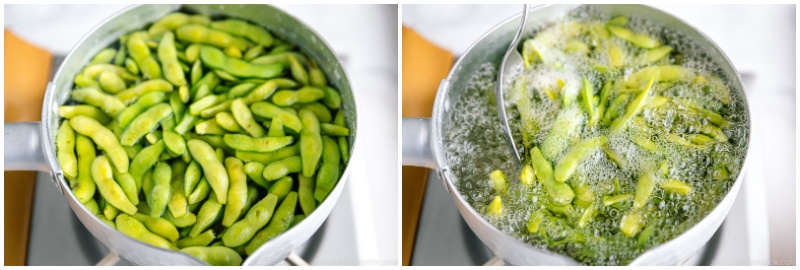











Got some fresh edamame from the farmers market and wasn’t sure how to cook them. So glad I found this recipe. I’ve made them twice now and they’ve turned out great.
Hi Fati! We are so happy to hear Nami’s post was helpful!
Thank you for your kind feedback! Happy Cooking!
How do I get 4% salt ?
Hi Farah, Thank you for trying Nami’s recipe.
4% is the brine-salt-to-water ratio. So if you are using 1000 ml, you will need 40g.
1000 milliliters water is equal to 1000 grams, so 1000 x 4% (0.04) = 40
We hope this helps!
This is my go to recipe to make edamame! Husband goes to town on them whenever I make it! Thank you 🙂
Hello there, Jean! Aww. We’re happy to hear this is your go-to dish.
Thank you so much for trying Nami’s recipe and for your kind feedback!
Is it 4-5 minutes after the point that water has boiled after putting the edamame in? 5 minutes has passed since, and the water hasn’t boiled again. Thanks.
Hi DDD, Thank you for trying Nami’s recipe!
If using frozen Edamame, please cook it for 4-5 minutes after adding it to boiling water. Please keep in mind that it does not need to be brought back to a boil but rather cooked until al dente. If you use frozen Edamame, a preboiled type, it will be shorter, so check the package instructions.
We hope this was helpful!
I was excited to try this recipe. I had frozen edamame that have cooking instructions of 4-6 minutes in the microwave that I purchased at Costco. I followed the kosher salt and water quantity posted here. I don’t know what happened but they were so salty I had to throw it all out 🙁 There was so much salt in the water it was accumulating on the side of the pan as the water was boiling. Next time I’ll have to half the salt.
Hi Cathy! Thank you for reading Nami’s post and trying her recipe.
We believe Edamame at Costco is lightly salted with sea salt and ready to serve with just quick reheat, so if you follow this recipe, it will be salty. Next time, you can boil them with water. We hope this helps!
How do you cook frozen shelled edamame? Gail C.
Hi Gail! Thank you very much for reading Nami’s post!
First, please check if your frozen shelled Edamame is fully cooked or not.
If it’s fully cooked Edamame, you can defrost it and use it for recipes. Otherwise, we recommend cooking it for less time than the package’s recommendation and making it Al dente. Or add 30 seconds to 1 minute to this recipe.
We hope this helps!
Hi Namiko,
Edamame is a great snack besides being healthy but if you like butter and garlic, another way to prepare the edamame to make it tastier but less healthy is to sauté it after it’s been boiled or steamed, in several tablespoons of butter w/2-4 cloves of garlic chopped fine which has been sauteed in the butter — cool and enjoy!
Hi Dan! It sounds great!
Thank you for reading Nami’s post and sharing your tip and experience with us!
Happy Cooking!💞
Hi im from uk.
Picked up these plants by mistake but i will grow them and cook them off when grown .
Give them a try!!
Hi, frankluxton! Thank you very much for reading Nami’s post!
Yes! Please try growing these plants! It will be fun and can enjoy in many ways!
Here is Nami’s Edamame recipes; https://www.justonecookbook.com/#search/q=edamame
We hope this helps!🙂
Thank you so much for this! I grew my own soybeans this year and just made my first batch of edamame to snack on. They cake out perfect and exactly as I remember them!
Hi Van! You grew your own soybeans! You’re amazing! I’m glad this recipe worked out. Thank you for your kind feedback. 🙂
Hi Nami, do you eat the pods as well like snow peas?
I have and they were a bit stringy but tasted ok.
I have never seen anyone else do this and wondered if it was ok.
Hi Charles! No, we never eat pods of edamame because they are too tough. 🙂
I enjoy edamame very much. Love the tip of cutting the ends off. Makes so much sense.
Hi Theresa! Thank you for reading this post! Hope this tip will improve the taste when you make it. 🙂
Yum I love edamame, I tried my very first ones at Nobu in Perth and we now have them at home for snacks.
Hi Linda! Wonderful! I didn’t know there is Nobu in Perth! It’s amazing how Japanese food is introduced. So happy you started eating edamame at home too! 🙂
Hi Nami, Darryl from Australia here. I come to LA quite often with my wife to visit her sister in law. Last time we came, we went to her favourite Japanese restaurant and had edemami as you have suggested with the exception it was sprinkled with grated French truffles. It was absolutely heavenly.
Hi Darryl, Nobu in Perth also has edamame with truffles and yes i agree “heavenly”.
Hi Darryl! That sounds amazing. I have truffle salt, maybe I’m going to try that first! 😀